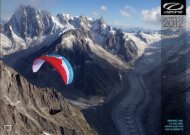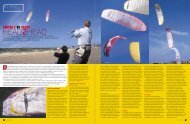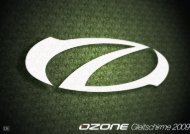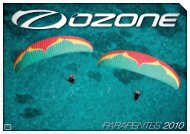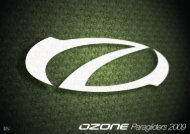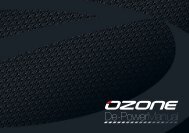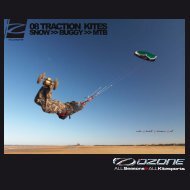PILOT'S MANUAL MANUEL DE VOL - Ozone
PILOT'S MANUAL MANUEL DE VOL - Ozone
PILOT'S MANUAL MANUEL DE VOL - Ozone
You also want an ePaper? Increase the reach of your titles
YUMPU automatically turns print PDFs into web optimized ePapers that Google loves.
NORMAL FLIGHT<br />
In the hands-up position in calm air, your glider will be stable in pitch and roll and<br />
achieve its 'best glide' speed. By applying the brakes approximately 30cm, the<br />
minimum-sink rate will be found. For increased speed or headwind glides, use<br />
the accelerator bar which will give you an increase in speed of up to 10km/h.<br />
Active Flying<br />
Active flying is the technique of using input to keep the wing as stable and efficient<br />
as possible. All good pilots do it. For example, on entering a thermal your<br />
glider will rock back slightly behind you; at this point you should reduce brake to<br />
allow the glider to come overhead again. As you leave the thermal your glider will<br />
try to accelerate and dive forward slightly, so apply a little brake to stabilise the<br />
wing overhead.<br />
When flying in turbulent air, you should be able to sense pressure loss in parts<br />
of the wing through the brake lines. You can then compensate by using a little of<br />
the appropriate brake until you feel the pressure return.<br />
This should all be done smoothly and progressively. Warning: over-braking your<br />
glider is dangerous and could lead to a stall.<br />
TURNING & THERMALLING USING WEIGHT SHIFT<br />
To familiarise yourself with your glider your first turns should be gradual and progressive.<br />
For efficient coordinated turns: look in the direction of your intended course, then<br />
lean into it. Your first input for directional change should be weight-shift, followed<br />
by smooth application of the brake until the desired bank angle is achieved. To<br />
regulate the speed and radius of the turn the outer brake should be used.<br />
Warning: never initiate a turn at minimum speed (i.e. with full brakes on) as you<br />
could risk entering a spin.<br />
WING-OVERS<br />
OZONE paragliders are not designed for aerobatic flying. The limit is tightly<br />
banked S-turns, commonly known as wing-overs. These must not exceed 45<br />
degrees of bank. Warning: uncoordinated wing-overs can lead to large asymmetric<br />
collapses and therefore tight turns should never be executed near the<br />
ground.<br />
12




